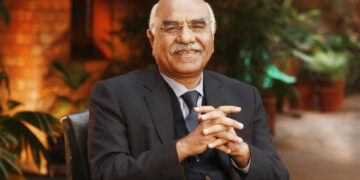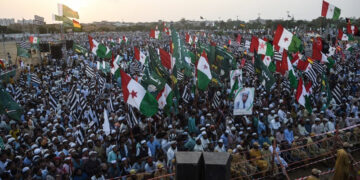
The veracity of statistics on poverty has always been a matter of painful bickerings in Pakistan.
This has generally been due to the desire of the successive incumbent governments to paint a rosy, at times an exaggerated picture of the reduction in poverty level and the demand of the opposition and academic circles to adopt a transparent and universally-recognised mechanism to measure this aggregate.The data on poverty during the tenure of present PPP coalition government has been so controversial and the discussion about the subject so intense that the Planning Commission has been forced to withhold the relevant data, arguing that the poverty-debate is a donor-pushed agenda that has lost its relevance or propriety.
The chapter on poverty was also conveniently omitted from the latest Economic Survey of Pakistan released annually. In a bid to resolve the lingering controversy and under mounting pressure from the donors, the government has, however, changed its stance now and decided to release relevant statistics of Pakistan Social and Living Standard Measurement (PSLM) Survey 2010-11 along with data programme files in order to enable interested parties to draw their own conclusions.
The latest controversy regarding poverty estimates was primarily due to the findings of a committee constituted by the Planning Commission, indicating that the incidence of poverty in the country declined from 17.4 percent in 2007-08 to 12.4 percent in 2010-11 despite macroeconomic instability, sluggish growth and double-digit inflation which did not support such a claim. It was reported that 7.1 percent of the poor were living in urban areas while 15.1 percent in rural areas. According to the methodology employed, if a person is able to consume 2,350 calories per day – which costs Rs 1,745 per month – then the individual is assumed to be living above the poverty line.
The official findings also showed that there has been a decline in both poverty and inequality from 2008 to 2011 – a rare combination which was not even achieved during Musharraf’s regime when poverty witnessed a massive reduction of 10 percent from 2000-01 to 2004-05. It is also interesting to note that though the government has not made loud claims due to fears of a backlash, the country, according to the available data, has already achieved the desired level of poverty alleviation as stipulated in the Millennium Development Goals which require a reduction in poverty level by half during 25 years of implementation from 1990-2015. In 1990, the estimated poverty level in Pakistan was 26.1 percent. The target seems to have already been surpassed, without achieving sustainable growth.
We are of the view that given the raging controversy on the subject, everyone, irrespective of his or her prejudices and political affiliations, needs to be more objective and ingenuous with a view to developing a consensus on the issue. Unfortunately, however, the data on poverty has been so much politicised that it is now seen as an ultimate yardstick of a government’s performance, forgetting the fact that other economic aggregates or political and social developments could also be important indicators to judge a government’s competence.
Also, a government’s performance cannot be evaluated in a vacuum. For instance, natural calamities or other issues like terrorism or militancy at a particular time might have consumed so much of a country’s resources and sapped its strength that economic considerations including poverty reduction might have been relegated to a secondary position. In such a situation, it would be preferable to assess a government’s success through some other means. Anyhow, we feel that it was sensible on the part of the present government to release the latest poverty data hidden in its files up to now.
Though very much belated, it would satisfy the donors’ requirement to disclose such data and make it easier for the country to seek soft loans and grants at international forums. However, it would be interesting to see the reaction of international community and multilateral institutions to such a “highly positive” development when almost all other economic aggregates were deteriorating. Domestically, the release of data could strengthen the demand for the constitution of an impartial body and putting in place a neutral and highly professional mechanism to compile data on poverty so that it is acceptable to all and sundry in the country and this controversy is put to rest forever.
Already, some of the independent experts are suggesting to the government to change the consumption-based poverty calculation methodology, terming it a flawed mechanism. Also, there are demands to hire a foreign expert to resolve the issue once and for all. In this connection, the Planning Commission is reported to have been advised to invite international poverty expert, Angus Daton, to evaluate the domestic methodology of evaluating poverty. It may be recalled that an international expert had also played a key role in resolving controversies on poverty issues in India. Anyway, such a route must be adopted soon since economic data cannot be held hostage to political bickering for long and its accuracy needs to be guaranteed in future.
While there is an urgent need for acquiring perfection in compiling poverty data due to a variety of reasons, the doubting Thomases may also like to reconsider their positions. Yes, there could be valid reasons to believe that the poverty level has a greater chance to increase during a period of low growth and high inflation but that is only a part of the story, though arguably a major one. The PPP government could be taken to task due to a number of weaknesses but the estimated reduction in poverty during its tenure may have been the result of certain developments or advertent or inadvertent policies. For instance, a large proportion of our population lives in rural areas and agricultural sector has not only performed reasonably well but the prices of agricultural products have risen markedly during the last few years. Besides, a large part of home remittances which have reached record levels in the recent years has flowed to the households in rural areas where poverty is much more rampant.
Also, the outreach of social safety programmes such as Benazir Income Support Programme (BISP) and Waseela-e-Haq seem to have expanded considerably in the recent past. It is also very important to note that according to detailed poverty statistics, a considerable part of our population is concentrated on the margins of poverty and, as such, a slight change in incomes due to the aforementioned initiatives or developments could make a lot of difference to the overall poverty profile in the country.
These observations are not meant to confirm or deny the accuracy of latest statistics on poverty but only to suggest that such information should not be outrightly rejected before it is given a fair chance of appraisal. Anyhow, the job of measuring poverty level should be left entirely to professionals in the field who need to devise a mechanism which reflects reality on the ground and is trusted by everybody without any kind of reservations. – Brecorder











